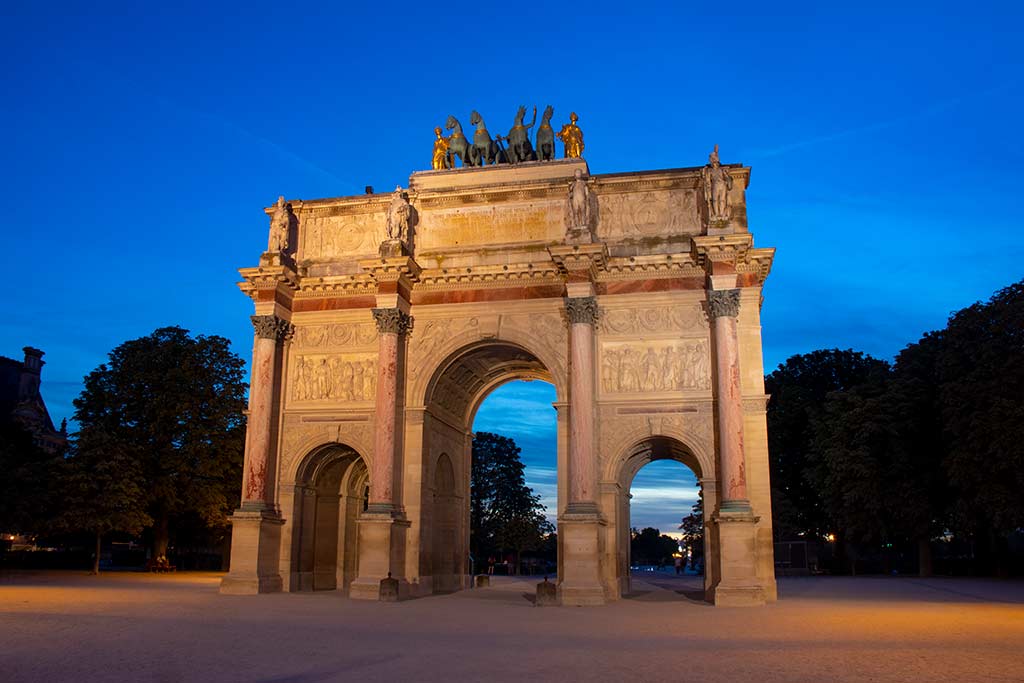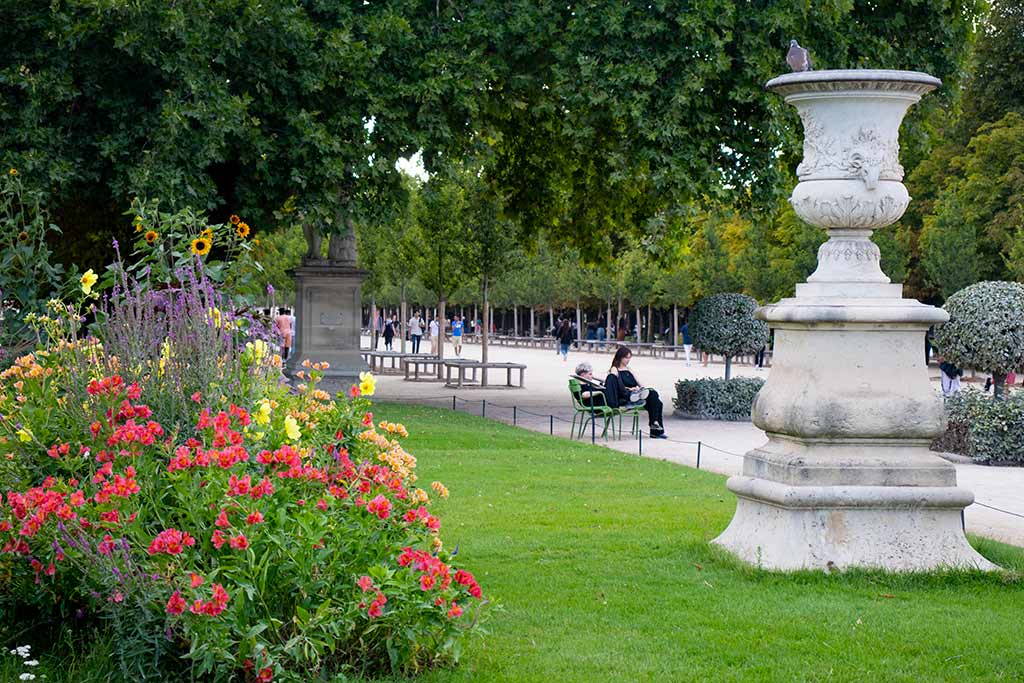The Tuileries Garden Paris is one of the most famous and best Parisian parks. If you’ve been to the Louvre Museum then you’ve seen the Tuileries, with its flower beds, statues and view to the distant Arc de Triomphe.
It’s where Parisians come to hang out and is a great place for you to do the same.
There is so much to see in the Tuileries, from its monumental vistas to its intimate corners where you can enjoy a picnic or a book. There’s also plenty for kids to do with a funfair and carousel in the summer.
In this Tuileries Garden guide I show you what there is to see and do, and advise on how to get there and what to see nearby. Enjoy!
Why Visit The Tuileries Garden


The Tuileries Garden is one of the most famous gardens in Paris, and one of the most beautiful parks in the city. There is so much to see and do in the Tuileries Garden in Paris, from admiring the statuary and architecture to relaxing and reading under the trees, or enjoying the fun fair in summer.
The Tuileries is an integral part of monumental Paris, forming part of one of the most famous views in Paris, from the Louvre and Arc de Triomphe du Carrousel to the more famous Arc de Triomphe at the end of the Avenue des Champs-Elysées.
The Garden is immensely popular with Parisians, and a great place to watch the world go by.
The Tuileries Garden Paris is also home to one of the best art museums in Paris, the Orangerie, and the Jeu de Paume, a former tennis court now repurposed as a photography museum.
See Also: Parc Monceau Paris – a gorgeous folly-filled park near the Arc de Triomphe
Tuileries Garden History

The Tuileries Palace and Garden were founded by royal widow Catherine de Medici in 1564. The palace was to be her new principal residence, but wasn’t completed for over a century.
The land intended for use as a Garden had previously been the site of tile making factories (tuileries), and the name remained in use thereafter. Catherine de Medici commissioned the creation of an Italian-style Renaissance garden with parterres, small trees, a grotto and a labyrinth.
Louis XIII inherited the Garden in 1610, and enclosed the Tuileries Garden, using part of it as a hunting ground and some land was used as a small zoo.

Louis XIV oversaw the completion of the Tuileries Palace in 1664. It occupied the area of land at the entrance to the Louvre complex (at its west end – and the east end of the Tuileries park). He also commissioned André Le Notre to re-design the Tuileries Garden, transforming it into a formal French garden.
Many of its features survive today, including the avenues of trees, the view along the grande allée through the middle of the Garden and the Bassin Octagonal, the pond at the west end of the Garden.
Louis XIV left Paris for Versailles, and from 1667 onwards the Tuileries Garden was open to the public – except for lackeys, beggars and soldiers.

The Tuileries Garden was the starting point of the first hydrogen balloon flight in 1783.
The deposed Louis XVI and Marie Antoinette were held under house arrest in the Tuileries Palace between September 1791 and August 1792, and his Swiss Guards were eventually massacred by Revolutionaries in the Tuileries.
In the early 18th century, Napoleon ordered the construction of the Arc de Triomphe du Carrousel (see below) and the Rue de Rivoli along the northern side of the Tuileries Garden.

Napoleon III made significant changes to the Tuileries Garden in the mid-19th century. He added more statues and beds of flowers around the Carrousel part of the Garden, and two buildings at the western end of the garden – the Jeu de Paume and Orangerie.
The Tuileries Palace was burned down in 1871 during the Paris Commune, eventually leaving the Garden and its surroundings much as they are today.
What To See In The Tuileries Garden
1. Arc de Triomphe du Carrousel

The Arc de Triomphe du Carrousel, inspired by the arch of Septimius Severus in the Roman Forum, was built between 1806 and 1808 by Napoleon Bonaparte to commemorate some of his own victories.
The more famous Arc de Triomphe – which you can see from the Carrousel arch – was started the same year but took far longer to complete, finally being inaugurated in 1836.
Some of his victories – depicted in marble bas-reliefs – include the Battle of Austerlitz, and his entry into Vienna and Munich. The quadriga – four horses – on the top of the arch are a copy of the Four Horses on the façade of St Mark’s Basilica in Venice.
2. Enjoy The Vista To The Arc de Triomphe

The Tuileries Garden forms part of the Axe Historique, or Historic Axis, a 6-mile (9 km) vista from the Louvre to the Arc de Triomphe and La Defense.
The view extends along the main avenue of the Tuileries Garden, the Grande Allée du Jardin des Tuileries, to the Obelisk in the Place de la Concorde and the Arc de Triomphe Paris. From ground level in the Tuileries, you can just see the top of the Grande Arche de la Défense.
The Grande Allée passes through the Grand Couvert, the wooded central section of the Tuileries Garden.
3. Tuileries Garden Carousel


The Tuileries Carousel, which is located in the same part of the Garden as the fun fair, is one of the most popular carousels in Paris. Like other Paris carousels it has a theme, in this case Paris landmarks and views, including obvious favourites such as the Eiffel Tower, Arc de Triomphe and Sacré Coeur.
The Paris carousels are enormously popular with kids, and you can either buy single ride tokens or ten for a slightly discounted rate.
4. Tuileries Garden Ferris Wheel

The Roue de Paris (Wheel of Paris) used to be located just outside the Tuileries Garden on the Place de la Concorde, but is now located within the Garden. Many websites still state that it’s in the Place de la Concorde.
This is not the case. It’s located in the northern part of the Tuileries Gardens, the Esplanade des Feuillants which runs parallel to the Rue de Rivoli.

It is usually open daily from 1000 to midnight, and the ride costs €15 per person. That’s a lot for a family for a 12-minute experience. We didn’t do the ride, but I’d imaging you’d get some interesting views from around the top – 60 metres above ground level – in good weather.
5. Tuileries Cafes And Restaurants

There are several cafes and restaurants in the Tuileries Garden. It’s a wonderful place to sit down and enjoy a drink or meal, but also an exorbitantly expensive one.
I ate at the Petit Plisson many years ago and have also had a drink at the Café des Marronniers in the past. However, you pay for the roof for the privilege of the setting, with half a litre of Kronenbourg costing an eye-watering €9, and a hot dog around the same. If you want to sit down for a salad or light meal and a glass of wine, count on over €20.
6. Picnic in the Tuileries

Even without the astronomical prices (for not particularly good food) the Tuileries Garden is perfect picnic territory. You could find a clear spot and lay out a blanket, or find one of the ubiquitous metal green chairs you find around all of the best parks in Paris.
As for food, pick up some baguettes from a local boulangerie, and whatever else you desire from a local épicerie (grocer’s) or supermarket. Don’t forget a bottle of wine, of course. You’ll find plenty of places to relax and enjoy your food and drink.
7. Walks in the Tuileries Garden

Except for a stroll along the famous Axe Historique, I’ve never planned a walk in the Tuileries, even when I lived in Paris in the early ‘90s. All I ever did was wander, and unless there is something specific you want to see I suggest doing the same.
Some of my favourite parts of the Tuileries Gardens are the shaded areas around fountains in the Grand Couvert section of the Garden. I’ve often found these are good places to find vacant green chairs, on which you can sit back and savour a slice of Parisian life.
8. Tuileries Gardens Statues


The statues in the Tuileries Gardens in Paris are very diverse in age and style. Two monumental statues, The Tiber and The Nile, are believed to be the oldest statues in the Tuileries, dating from the late 17th century.
The equestrian Mercury and Pegasus and La Renommée were from the early 1700s, and adorn the west terrace of the Tuileries Garden.
Most of the statues in the open end of the Garden near the Louvre – sometimes called le Grand Carre – date from the 19th century, and include Theseus Fighting the Minotaur by Etienne Jules Ramey and Le Bon Samaritain by Francois Sicard. There are also several works by the great Auguste Rodin.
Statues from the 20th century can also be found around the gardens, and one of the most impressive pieces I came across is Gaston Lachaise’s Standing Woman, from 1932.
9. Eiffel Tower Views

The Jardin des Tuileries also commands some of the best Eiffel Tower views. The Bassin Octagonal, near the Place de la Concorde end of the garden, is a great place to admire the view, as is the higher West terrace overlooking the Place de la Concorde.
You can also enjoy some great views of the Eiffel Tower from the east end of the Tuileries, near the Arc de Triomphe du Carrousel.
10. Jeu de Paume and Orangerie

These two buildings in the north-west and south-west corners of the Garden respectively, have been used as art museums for much of the last century.
The Orangerie, like many similar buildings across Northern Europe, was built to house and protect citrus trees during the winter months. It has housed Monet’s Water Lilies series since 1927, as well as a strong collection of other Impressionist works. As you walk towards the Place de la Concorde, it’s up the gentle ramp to your left.
The Galerie Nationale du Jeu de Paume now houses a collection of modern art and photography. For a short period in the 1980s this was my favourite museum in Paris, as it housed a superb collection of Impressionist paintings.
The collection was then moved to the new Musée d’Orsay, the former station across the river, and can be seen in the 5th floor galleries there.
11. Place de la Concorde

The Place de la Concorde is located at the western end of the Tuileries Garden, and the Obelisk is part of the grand vista from Arc to Arc that I’ve described earlier in the article.
The West Terrace of the Jardin des Tuileries offers a wonderful view of the vast square, especially from the Jeu de Paume side to the north of the Grande Allée.
I returned to this spot around sunset a couple of times during my recent Paris visit, and loved the view over the Place de la Concorde with the statue of Mercury riding Pegasus by Antoine Coysevox on the terrace.
There is also a lovely little café open near this statue during the summer months, a wonderful place to savour the end of the day.
The Place de la Concorde is enormous, full of huge open spaces, but it’s one of the most beautiful squares in Paris with its fountains, Neoclassical buildings and Eiffel Tower views.
Take car when crossing the Place de la Concorde on foot as drivers are prone to pedal to the metal and hit the accelerator hard after being cooped up in traffic jams. Stick to the crossings only.
Where Is The Tuileries Garden

The Tuileries Garden is located in the 1st arrondissement of Paris, with the Louvre at its eastern end and the Place de la Concorde at its western end.
The Tuileries Gardens are bordered by the Rue de Rivoli, one of the most famous streets in Paris, to the north, and the Quai des Tuileries and River Seine to the south.
How To Get To The Tuileries Garden

Getting to the Tuileries Garden by public transport is easy, with Metro and bus options.
At the Louvre end of the Tuileries Garden, the 39, 68, 69 and 75 buses stop on Place du Carrousel, between the entrance pyramid of the Louvre and the Arc de Triomphe du Carrousel.
If you’re traveling by Metro this part of the Garden, lines 1 and 7 stop at Palais-Royal-Musée du Louvre. Place du Carrousel is only a three-minute walk away.

If travelling by Metro line 1, you can choose from two additional stops. The Tuileries Metro stop on Rue de Rivoli, on the north side of the Garden, is very convenient for getting to the heart of the Garden and wandering.
It’s a short walk from there to the Grande Roue de Paris, the ferris wheel that dominates the Tuileries skyline.
Line 1 also stops at Concorde, which is on the north-east corner of the square of the same name. It’s a two- or three-minute walk from there to the west entrance to the Jardin des Tuileries.
It’s worth bearing in mind that lines 8 and 12 also stop at Concorde.
Alternatively the 72 bus runs along Rue de Rivoli and the Tuileries as it heads west to Porte de Saint Cloud, and along the Quai des Tuileries and the river as it heads east towards the Gare de Lyon.
Things To See Near The Tuileries Garden Paris

This could easily be an exhaustive list so I’ll stick to the immediate vicinity of the Tuileries and Louvre for the sake of brevity.
The Rue de Rivoli runs along the northern side of the Tuileries, and is famous for its hotels and upmarket shops.
The Palais Royal is close by, as is Place Vendome, one of the most famous squares in Paris with its landmark bronze column and statue of Napoleon.

There are some fascinating buildings around Place de la Concorde, at the west end of the Tuileries. The Hotel de la Marine is a splendid Neoclassical palace that was headquarters of the French Navy for over 200 years.
It has been restored to its former glory and is the best place to visit in the city if you want an insight into the life of the French aristocracy in the 19th century.
La Madeleine, a short walk off the Place de la Concorde, is one of the most famous churches in Paris, with a Classical-style temple portico. The dimly-lit Baroque interior is well worth seeing, and its famous organ is often used for concerts and recitals.
The funeral of composer Frédéric Chopin was also held there in 1849.

The most famous street leading off the Place de la Concorde is the Avenue des Champs-Elysées, which leads to the Arc de Triomphe.
There’s not a great deal to see along the street, but the view of the Arc is one of the best things to see in Paris, an absolute must if you’re visiting Paris for the first time.

If you turn from the Place de la Concorde, you’ll reach one of the most scenic stretches of the river Seine, with several famous Paris bridges gracing the scene.
The Pont de la Concorde (built in 1791) is one of the oldest bridges in Paris, and the next bridge downstream is the Pont Alexandre III, an exuberant Belle Epoque beauty with great views of the Invalides dome and Eiffel Tower.
Tuileries Garden Paris – Final Words
The Jardin des Tuileries is one of the most beautiful gardens in Paris. It’s also one of those quintessential places to while away a few hours, whether you’re just wandering or enjoying a picnic.
We’ve written about a few other parks in Paris, including the wonderful Parc Monceau near the Arc de Triomphe.
The Jardin du Luxembourg is another of the most famous Paris parks, just across the Seine. And we also recommend the Square du Vert Galant, at the tip of the Ile de la Cite. It’s also within sight of two of the most famous Paris bridges, the Pont Neuf and Pont des Arts.
Discover more of our articles about places along the river Seine in Paris:
- La Sainte-Chapelle Paris – one of the great churches of the Gothic Age
- Bir-Hakeim Bridge Paris – gorgeous bridge with outstanding Eiffel Tower views
- Statue of Liberty in Paris – seeking out the replicas of Lady Liberty in Paris
Check out more of our articles on the Left Bank in Paris here:
- Pantheon Paris – the amazing national mausoleum of France – and one of the best viewpoints in Paris
- Saint Etienne du Mont – one of the most beautiful churches in Paris, and resting place of St Genevieve, patron saint of Paris
- Saint Severin Paris – glorious late Gothic church with superb modern stained glass
- Saint Sulpice Paris – great temple-like church, the second largest in Paris after Notre Dame
- Saint Germain des Prés – the oldest church in Paris, and one of the city’s most beautiful
- St Julien le Pauvre – tiny, humble medieval church within sight of Notre Dame
Explore more of our guides to the Paris Right Bank and Montmartre here:
- Visiting Sacré Coeur – the complete guide to the famous basilica in Montmartre
- Abbesses Metro Station Paris – the most beautiful Metro station in Paris
- Rue de l’Abreuvoir – one of the most picturesque streets in Montmartre and Paris
- Rue St Rustique Paris – quiet hidden Montmartre gem and one of the oldest streets in Paris

David Angel is a British photographer, writer and historian. He is a European travel expert with over 30 years’ experience exploring Europe. He has a degree in History from Manchester University, and his work is regularly featured in global media including the BBC, Condé Nast Traveler, The Guardian, The Times, and The Sunday Times. David is fluent in French and Welsh, and can also converse in Italian, German, Portuguese, Spanish, Czech and Polish.


